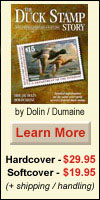 |
10% off on
web orders over $100 |
|
|

|
|
State program updates; USPS selling junior stamp
This month’s column leads off with updates for the Wisconsin, Hawaii and North Dakota duck stamp programs.
In early March, the Wisconsin Department of Natural Resources issued some policy changes regarding the sale of its duck stamps.
Previously, most waterfowl, fish and game stamps from previous years were available for sale. Beginning this year, sales will be limited to stamps issued in the current year and the previous year.
Details concerning the 2002 Wisconsin duck stamp will appear in a future column.
Collectors interested in Wisconsin’s duck stamp program are encouraged to contact the Wisconsin Department of Natural Resources, 101 S. Webster St., Box 7921, Madison, WI 53707.
The cost of a 2002 Hawaii wildlife stamp will jump from $5 to $10. The stamp pictures a Chukau partridge.
According to a Dec. 20, 2001, story in the Honolulu Star-Bulletin, which quotes an undated release from the Hawaii Department of Conservation, the additional funds will be used to lease hunting land on Lanai and to develop other mammal and bird hunting areas.
Hawaii hopes to encourage stamp purchases by offering a wholesale rate of $7.50 per stamp for purchases of 10 stamps or more at a single time.
Hawaii also requests a processing fee of $5 per item for special requests, such as corner-margin singles from separate panes.
For example, if a collector ordered 10 corner-margin singles, he would pay a $50 processing fee on top of the $100 for the stamps.
This processing fee seems counterproductive to me, because it is not likely to spur a great deal of extra sales.
Thanks to Clarence McIntosh for keeping me informed of recent changes in the Hawaii program.
The North Dakota Game and Fish Department advised me in early March that its 2002 pictorial duck stamp will not be available.
This is because a fire in October 2001 nearly destroyed the Depot Gallery and Frame Shop in Sullivan, Ill., the printer and publisher for the stamp.
The firm will offer a nonpictorial hunting stamp in place of the duck stamp. According to firm representative Dan Harshman, several states might be affected by the 2001 fire, which destroyed the printing press.
As more information becomes available, I will pass it along in a future column.
•
Orders for junior duck stamps no longer will be handled by the United States federal duck stamp office in Washington, D.C.
The stamp is now available from the Stamp Fulfillment Services mail-order center of the United States Postal Service in Kansas City, Mo.
The 2001-02 $5 junior duck stamp, illustrated nearby, may be ordered by calling the fulfillment center at 800-782-6724. Request USPS item No. 540010 for a single stamp.
Selling junior duck stamps through the center is a test, so if you feel so inclined, buy a stamp to show your support.
The duck stamp office and the Postal Service will decide by the end of this year if the center will continue to sell junior duck stamps.
In the meantime, I hope this increased exposure will result in more sales for the junior duck stamp program.
The junior duck stamp program began in earnest in 1993. Each issued stamp has a face value of $5.
Junior duck stamps are not required (or valid) for hunting, but they represent a true bonanza to youth in all 50 states, Washington, D.C., and the U.S. possessions.
The stamps are very well-done, and the entries in each year’s junior duck stamp contest are quite spectacular.
The program has been well-received, and the contest offers competition for many young artists.
Kids with talent blossom, while others learn to develop their skills. All of this takes place under the skillful guidance of their teachers.
I heartily support this program and hope that one day the Department of the Interior will make the junior duck stamp valid for hunting.
Why not change existing law to require hunters 16 years old and younger to buy a junior duck stamp?
The cost is only $5 per stamp, about the cost of a box of shotgun shells, and the requirement to buy a stamp would raise a lot of additional funds.
The answer, to me, seems obvious. The stamp should be valid for hunting. But what politician in his right mind would suggest a tax on kids who hunt ducks? Certainly not anyone who wants to get re-elected, I’d wager.
However, some kids who hunt can kill more ducks than many adults can, so why not teach them the cost of their hunting pleasure?
•
Here’s a teaser about duck flight speeds.
Most flying ducks exceed the 55 mph limit posted on many city highways.
Ground speed is determined by the ability of the duck and the prevailing wind.
Most ducks fly at about 40 mph to 60 mph, and up to 13 mph faster when being pursued.
The speed demon of ducks is the canvasback, which can reach speeds of 70 mph and is capable of roughly 100 mph with a good tail wind.
Canvasbacks are pictured on the $15 federal duck stamp of 1993.
For the record, huge Canada geese, pictured on the $15 stamp of 1996, fly faster than the popular (and much smaller) mallards and pintails, respectively, shown on the $15 stamp of 1995 and the $15 stamps of 2001.
The next time you look at your collection of beautiful duck stamps, think of what marvelous creatures they depict.
Thanks to Ducks Unlimited for the trivia. More information is available at its web site, www.ducks.org.
|
|
|



















